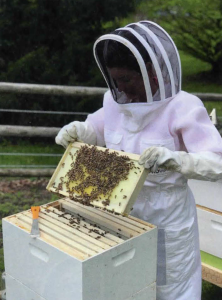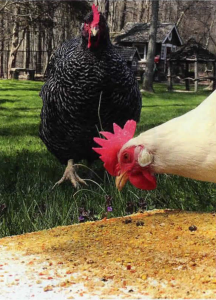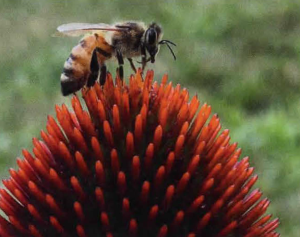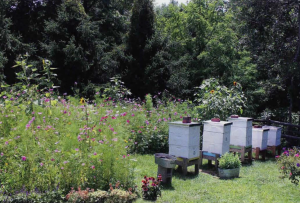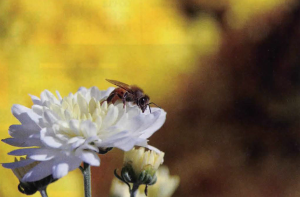By: Gail Damerow
This article originally appeared in the Winter 2018 issue of BEEKeeping Your First Three Years
Getting into beekeeping accidentally isn’t always the best approach, but it worked out well for Kathy Shea Mormino, better known for her chicken keeping skills. Kathy is recognized online as The Chicken Chick (ChickenChick.com). Her popular Facebook page has a following of more than 808,000 chicken enthusiasts who, since 2017 have followed Kathy’s venture into beekeeping.
The thought of becoming a beekeeper (or “beek,” as she calls it) didn’t enter Kathy’s mind until her horticulturist neighbor and frequent sidekick Julie the Garden Fairy (juliethegardenfairy.com) mentioned her interest in beekeeping. Kathy acquired a complete beekeeping starter kit from Harvest Lane Honey (harvestlane.com), planning to document her friend’s foray into bees online. Julie, however, in her eighth month of pregnancy, suddenly realized beekeeping was going to be too complicated an endeavor to take on with a new infant. Someone was going to have start keeping bees, Kathy reasoned, and that someone was Kathy.
Before Kathy’s first flock of chickens arrived she felt fairly well prepared. Her neighbor had chickens and asked her to collect eggs while she was on vacation. Upon her return, they discussed the idea that Kathy might like to keep a few laying hens of her own. The neighbor gave her a copy of Storey’s Guide to Raising Chickens by Gail Damerow, which Kathy studied thoroughly until she convinced herself she could handle the challenges of chicken keeping.
But, says Kathy, “Honey bees are such foreign creatures – creatures with reputations for inflicting pain at times.” Up to that point, she says, “I had no interest in keeping bees. I don’t use honey often. And I wasn’t looking for another hobby.” Still, she began a self-guided crash course in beekeeping.
Her first order of business was to immerse herself in the beekeeping blog HoneyBeeSuite.com and three books: Backyard Beekeeping: We Take the Sting Out of Beekeeping by Waite & Wells; Keeping Bees & Making Honey by Benjamin & McCallum; and, of course, The Backyard Beekeeper by Kim Flottum.
In May Kathy got around to unboxing the hive components and equipment, and was fortunate to find a seasoned local beekeeper to show her how to set up a hive and put on a bee suit. By this time Kathy had learned that Spring is not the right time of year to source bees; ordinarily people order bees in Winter for Spring delivery.
However, she also learned that beekeepers often catch and sell swarms. As it turned out, a backyard chicken keeper and fulltime beekeeper who lives not far from Kathy posted a video online of a swarm she had caught on the deck of her house. Enter Brenda Nye of Waggle Dance Apiary (www.waggledanceapiary.com).
Kathy contacted Brenda and arranged to purchase the swarm. The day Kathy went to collect her nuc, Brenda spotted a small swarm hanging from a tree behind her chicken coop and asked Kathy if she wanted to help catch it.
“Swarm catching,” observes Kathy, “is something of a right of passage in the beekeeping world. The goal is usually to experience a swarm catch within one’s first year, not the first day! I was game, so we suited up and headed to the tree with a cardboard nuc box and a pair of pruning shears.”
To Kathy’s surprise, “Catching this swarm had no big gotcha! moment. Everything proceeded in a calm, deliberate manner. Brenda sent me home with double the number of colonies I was expecting. That sounds a lot like chicken math, doesn’t it?”
Chicken math, Kathy explains for the benefit of the uninitiated, “is a force of nature that creates the perceived need to increase the size of one’s existing flock of chickens. The Force is formidable, undeniable, and knows no boundaries.” A lot of beekeepers can relate.
Chickens and bees “are both addicting hobbies and they’re both easily propagated,” says Kathy. “It seems wasteful not to hatch fertilized chicken eggs, and wasteful not to split hives and nuc frames with capped queen cells.” Another similarity Kathy sees is the keeper’s need to be knowledgeable about healthcare management, and disease and parasite diagnosis and treatment.
Although some chicken-and-beekeepers locate their hives inside or near their chicken runs, Kathy does not. With plenty of space in her backyard, she chose to position her hives in the best location for the bees. “I took into consideration the position of the morning sun, afternoon shade, flight patterns from hive entrances, known water sources (including a neighbor’s swimming pool), access to natural screening from tall evergreen trees along the property line, and proximity to my wildflower garden.”
Each of Kathy’s four dozen or so chickens has a name, and so do her bee queens. Her first queens from Waggle Dance Apiary swarms came with names: Ginger and Summer. “I liked the idea of being able to identify a hive by the name of its reigning queen,” says Kathy, “so I have carried on that tradition. I select my queens’ names based on what fits them.
“Sometimes their name relates to their landing board color. For example: Rosita reigns over the pink hive; Lean Jean, a skinny queen, resides in the green hive; and Jane reigns in the plain, unpainted hive. Sometimes I name my queens after the queen marking color for the year. Since Queen Summer was a 2017 queen, she was marked yellow; when Summer swarmed, I named her 2017 successor Buttercup. Buttercup’s name tied into the yellow marking on her thorax and the name of the title character in my favorite movie, The Princess Bride. Not all queens are named immediately – the name must fit Her Royal Beeness. I don’t like to rush into these weighty decisions.”
Kathy finds beekeeping much more challenging than chicken keeping, although she admits “That may be a function of the number of years I’ve been caring for chickens (9) versus not quite two years with bees. But it seems bees have many more moving parts. The condition of the bees themselves and the state of the hive aren’t as plainly observable as chickens, which makes troubleshooting more difficult. I can see a chicken preening excessively from inside the house at the kitchen window, tipping me off to the need to investigate whether mites or lice might be afflicting the bird, but observing the condition of bees is an intentional and more complicated undertaking.”
One of Kathy’s biggest challenges as a new beek is “Keeping my hands off the hives. It’s a lot like incubating eggs: the more one opens the hive or the incubator, the more disruptive it is to the population inside.”
“I’m curious. I want to see what’s going on inside my hives and I enjoy inspections, so I find it difficult to limit my visits to the number an experienced beekeeper might view as ‘normal’ or ‘necessary.’ I view inspections as an important part of my ongoing bee education.”
Essential to Kathy’s beekeeping education is Brenda Nye, who has become her mentor, or as Kathy calls it, Bee Sensei. “Brenda’s mentoring has been a terrific way for me to learn as I go. I was surprised that I wasn’t afraid going into beehives for the first time with my Sensei. She’s a relaxed, patient teacher who made me feel at ease around the bees. The first time I brushed bees off a frame under her watchful eye, she told me I was ‘a natural.’ That type of encouragement goes a long way toward boosting the confidence of any rookie.”
“I have had some amazing first year experiences and new beek proud moments. They include: catching a swarm with my Sensei on my first day of beekeeping; catching a swarm alone (while live-streaming it on Facebook!); successfully overwintering both my first hives; observing a queen piping inside a capped cell; witnessing a queen laying an egg; finding a queen on a landing board with the mating sign intact (which was a crazy cool thing to see!); and rectifying a laying worker hive by re-queening with a queen I had produced from a swarm frame.”
Kathy regrets that she went into the endeavor woefully under prepared. “I wish I had known I was going to begin keeping bees more than two months before diving in. Admittedly, attending formal classes would have been preferable. But, I began with two swarms last Summer and now I have five bustling hives. I’m either doing something right or my bees are working overtime to fix my mistakes!”
Gail Damerow is the author of Storey’s Guide to Raising Chickens, The Chicken Encyclopedia, and a flock of other books on poultry and related subjects including The Backyard Homestead Guide to Raising Farm Animals, which includes a chapter on keeping bees.





